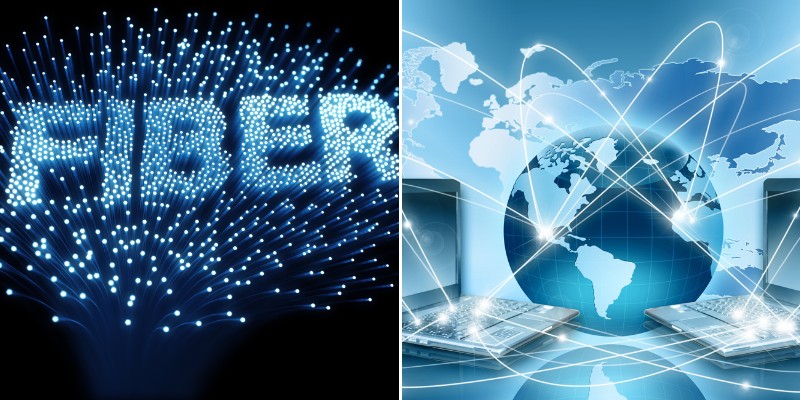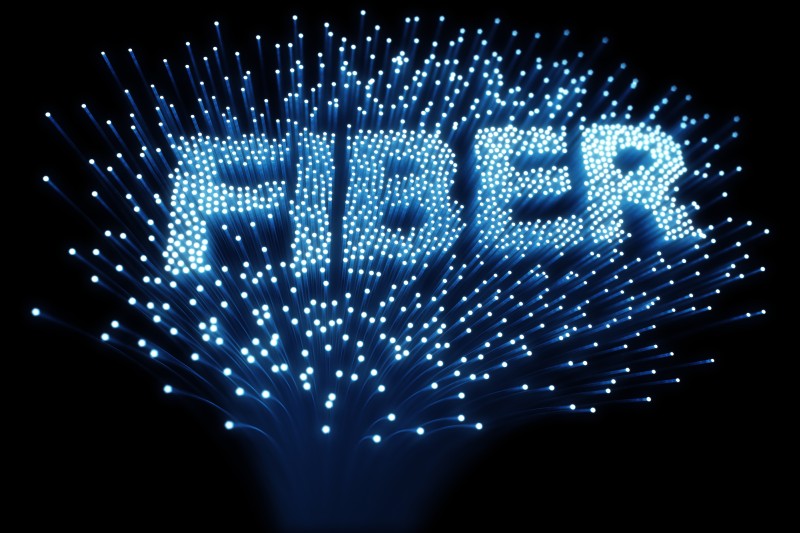August 6th, 1991, is a red-letter day in technology history. That’s the day the internet—the first website on the www specifically—opened for public use.

Back then, it was little more than a curiosity, and few people had access to it. In the years since, however, the internet evolved into a must-have tool for the modern digital age.
That happened in part because people’s options for connecting to the internet improved.
Today, the dominant types of internet service in the US are DSL, fiber-optic, and cable.
DSL’s the oldest of the trio, and cable’s the most widespread. Fiber-optic connections, however, are the newest, and some say best, option of all three.
It’s fast becoming a go-to internet connection option for both homes and businesses. Here are all of the major pros and cons associated with fiber-optic internet.
The Pros of Fiber Optic Internet Service
Even though fiber-optic internet service is a relatively new option for homes and businesses in the US, the technology powering it isn’t new at all.
Fiber optic cables consist of bundles of glass or plastic fibers that transmit data as bursts of light.
The technology’s been in use since the late 1970s, and it forms the majority of the global internet’s backbone networks.
Now, it’s becoming increasingly available to deliver internet connections straight to end users (also called FTTH – Fiber to the Home).
Here are the major advantages associated with fiber-optic internet.

Fiber Connections Support Higher Speeds
One of the biggest advantages of fiber-optic internet services is their speed. Fiber-optic cables now carry data faster than almost any other type of cable.
How fast? At the time of this writing, at least one fiber-optic internet provider in the US offers a plan with a symmetrical 5 Gbps speed rating.
At that speed, you could watch 200 movies in Ultra HD on Netflix at the same time.
And today’s speeds are only the beginning. The signaling technology used to transmit data over fiber cables is improving all the time.
In fact, scientists recently devised a signaling system that transmitted data over a fiber optic cable at 1.84 petabits per second.
For reference, that’s twice as much traffic as the entire internet produces each second, so it’s clear that fiber connections will continue to hold the speed record for a while.
Weather Conditions Don’t Disrupt Fiber Connections
Another major advantage of fiber-optic internet service is that it’s typically impervious to disruptions caused by poor weather.
One of the reasons for that is the fact that the majority of the fiber-optic infrastructure in the US is underground.
By comparison, a large percentage of the copper and coax cabling infrastructure, used to deliver other types of internet connections, is above ground.
That means poor weather, lightnings etc can either damage those cables or cause signal loss, thus disrupting service to end-users in the process.
The underground cabling makes fiber-optic internet service among the most stable type of connections available.
Isn’t Affected by Electromagnetic Interference
Since fiber-optic cables use bursts of light to transmit data, they’re not vulnerable to electromagnetic interference (EMI), either.
That stands in stark contrast to coaxial or copper cabling, which uses electrical signals to operate.
Those cables all contain thick shielding meant to block external EMI and prevent it from disrupting data transmission.
However, that shielding isn’t always effective, which creates the possibility of service disruptions caused by stray EMI anywhere along a cable run.
With fiber cabling, the only way to disrupt a signal is to physically sever the cable itself—which isn’t a frequent occurrence given that fiber cabling’s usually underground.
Available Symmetrical Speeds
For most of the internet’s history, end users relied far more heavily on downloading data from the internet rather than uploading data to it.
For example, loading a webpage requires significant download bandwidth and almost no upload bandwidth.
For that reason, older internet service types (such as ADSL and Cable Internet services) prioritized download channels and provided an asymmetrical connection. That means you’d get a fast maximum download speed and a much slower maximum upload speed.
Most fiber optic internet services, by comparison, offer symmetrical speeds. That means you can download and upload at the same ultra-fast speeds.
That’s especially useful now that more services require quick upload speeds, such as cloud backup and videoconferencing services.
Plus, such services show no signs of going away and will likely multiply in the years to come. That gives fiber-optic internet a critical advantage over alternative services.
Less Vulnerable To Eavesdropping
Although it’s not something the average user has to worry about, fiber-optic cables are also more secure than coax or copper cables.
They’re less vulnerable to eavesdropping and require some significant equipment, know-how, and access to penetrate, security-wise.
This means users of fiber-optic internet services don’t have to worry as much about transmitting sensitive information over their connections. In a world where cybersecurity is always top-of-mind, that can be a major selling point for some users.
Supports Longer-distance Connections
Fiber-optic internet services also enjoy an advantage over competitors when it comes to reach, too.
This is because fiber-optic cables offer less signal loss than coax or copper equivalents.
This means fiber-optic cables can carry data for much further before needing a signal boost to keep going. For end-users, this means getting service via a less-complicated infrastructure.
That translates into less chance of service degradations or outages. For providers, it means the ability to reach more locations with less cabling.
Fiber Cabling Is Thin and Lightweight
In addition to carrying signals further than alternative cabling types, fiber-optic cables are also much thinner and lighter than coax or copper equivalents.
This is mostly because they contain no metals and don’t have to worry about including thick shielding layers to prevent interference.
That makes the cabling itself easier for installers to work with. For end users, this means more reliable connections to their premises compared to copper-based cable networks.
Moreover, if the fiber cable needs to be run inside the house, it makes cabling easier to reach the home router or switch of the house network.
The Cons of Fiber Optic Internet Service
Although fiber-optic internet services sound like a dream come true for internet users, they do come with some disadvantages, too.
For some users, the cons of fiber-optic internet services may be significant enough to warrant exploring other alternatives. Here are the major cons associated with fiber-optic internet services.
Lack of Widespread Coverage
One of the biggest problems with current fiber-optic internet services in the US is a lack of availability.
At the time of this writing, only approximately 43% of the country even has access to fiber-optic internet service.
That’s compared to an estimated 80% to 90% of places in the US that have access to cable internet services.
DSL is even an option for about 89% of the country—and that’s even as big providers like AT&T pull the plug on their DSL networks.
Higher Costs
Another downside to fiber-optic internet services is their cost. In the US, the average fiber-optic internet service package will set you back around $50—and that’s before taxes and fees.
For most people, though, costs can be much higher than that. The trouble is that fiber-optic networks cost a great deal to install and expand, so providers seek to recoup their costs via higher monthly service fees.
However, fiber-optic cabling has a lifespan of 50 years or more, so it’s reasonable to expect that prices will begin to decline as providers complete their network rollouts.
Fiber Cabling Is Relatively Fragile
One of the advantages of fiber-optic internet we identified earlier was that it wasn’t vulnerable to weather-related disruptions.
For the most part, that’s because the cabling tends to be underground. One of the major reasons for that is the relative fragility of fiber-optic cables.
Since they’re made of fine glass or plastic threads, even a tiny cut into a fiber-optic cable could cripple it.
By comparison, coax and copper wires must be almost totally severed before they’ll fail.
Plus, it’s far easier to splice a severed conventional cable, while a damaged fiber-optic cable requires significant expertise and specialized equipment to repair.
The Bottom Line
The main takeaways here are that fiber-optic internet services offer some of the fastest symmetrical service speeds available and are the most reliable connection type on the market today.
Fiber-optic networks are also evolving to support even faster connection speeds and additional services every day. That means they’re the most future-proof internet service type you’ll find.
However, most people should expect to pay more for a fiber-optic internet service plan than they would for an alternative.
That is—if they’re even eligible to sign up for fiber-optic service in the first place. Due to the lack of coverage of fiber-optic networks in the US right now, more than half of the population still can’t get fiber-optic internet, even if they want it.
The good news is that providers continue to expand their networks, giving more people the chance to choose fiber-optic internet service for their homes and businesses.
And that’s a good thing because it’s only a matter of time before alternatives like cable and DSL internet fall by the wayside.
In the meantime, though, fiber-optic internet is a great option where available and is well worth considering for those looking for the best internet service possible.
Leave a Reply